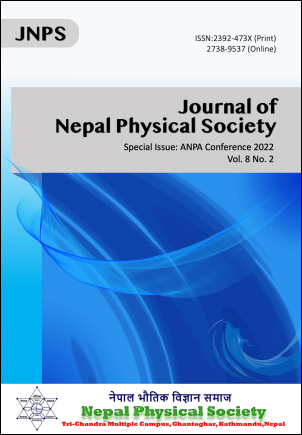Study of an Isolated Dust Structure Nearby the White Dwarf WD0011-399 Using IRIS, AKARI, and WISE Data
DOI:
https://doi.org/10.3126/jnphyssoc.v8i2.50140Keywords:
White Dwarf, IRIS, AKARI, WISE, Dust color temperatureAbstract
During the asymptotic giant branch (AGB) phase, a major fraction of mass is spread by the stars (0.6 - 10 M⊙) in the interstellar medium (ISM) in the form of dust. In the left phase of the post-main sequence evolution in the Hertzsprung-Russell (HR) diagram, these dust are found to be surrounding the white dwarfs (WD). Some small fraction of dust is also formed in the circumstellar shells and cavities around WD which is usually a source of infrared (IR) excess. The formation and evolution of such IR dust structures are the results of high-pressure events such as the Helium shell flash (thermal pulse) and stellar winds, and such structures are crucial in the study of interaction phenomena in ISM. This research project is focused on the study of an isolated dust structure near the white dwarf WD0011-399 located at R.A. (J2000) 00h 13m 47.48s and Dec. (J2000) -39° 370 24.2800 using Improved Reprocessing of the IRAS (IRIS), AKARI and Wide-field Infrared Survey Explorer (WISE) surveys from SkyView Virtual Observatory along with SIMBAD Astronomical Database and Gaia Archive of ESA. The size of the cavity under study is 7.43 pc×2.90 pc, 2.99pc×0.99pc, and 1.26×0.53pc with an inclination angle of 71.12°, 75.73°, and 68.48° respectively in IRIS, AKARI and WISE data suggesting the cavity is neither a face-on nor an edge-on. The relative flux density of the region has been studied through pixel extraction of Far-Infrared (FIR) images and dust color temperature along with dust mass has been calculated. Using IRIS data, the temperature of the isolated region is found between a maximum value of 36.82±4.30 K to a minimum of 22.59±2.32 K with an offset of 14.23 K. The average temperature of the region is 28.22±0.18 K. Following similar procedures for AKARI data, the temperature is found between a maximum of 26.37±3.56 K and a minimum of 16.32±1.47 K with an offset of 10.06K. The average temperature is 19.25±0.15 K. Similarly, using WISE data, the temperature is found between a maximum of 353.72±18.54 K and a minimum of 307.24±4.69 K with an offset of 46.48K. The average temperature is 316.62±0.81 K. High value of offset temperature suggests that the cavity might be evolving with disruptions from background radiative sources. Approximately Gaussian distribution of the temperature in all the surveys implies that the region might be tending towards local thermodynamic equilibrium. The total mass of the structure is estimated to be around 0.03±1.5×10−6M⊙, 1.6×10−3±1.4×10−5 M⊙, and 10−7±3×10−10 M⊙ using IRIS, AKARI, and WISE data respectively. The Jean’s mass of the structure is calculated assuming the structure is a non-degenerate gas, which is estimated around 2001.93M⊙, 178.44M⊙, and 121.47M⊙ respectively using IRIS, AKARI, and WISE data. Since Jean’s mass is much greater than the mass of the structure there seems no possibility of star formation within the region of interest. The color maps illustrate identical distribution for all wavelengths, however, no significant relation is observed between dust color temperature and dust mass.
Downloads
Downloads
Published
How to Cite
Issue
Section
License
All right reserved. No part of this Journal may be reproduced in any form or by any electronic or mechanical means, including information storage and retrieval system, without permission in writing from the publisher, except by a reviewer who may quote brief passage in a review. The views and interpretation in this journal are those of author(s) and they are not attributable to the NPS.




